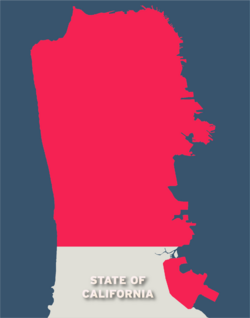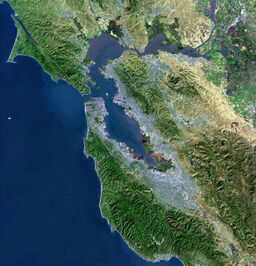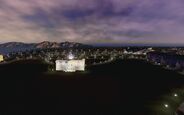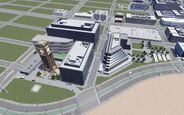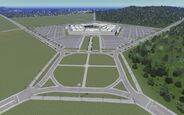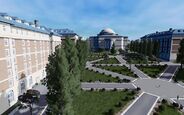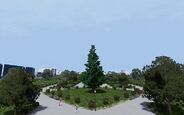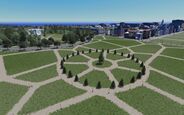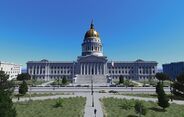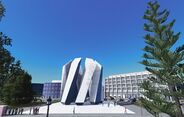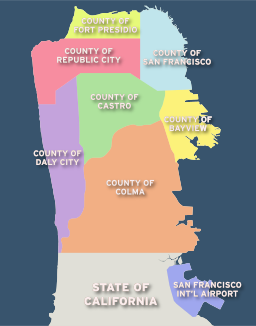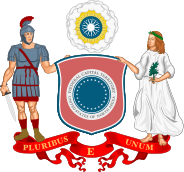Fœderal Capital Territory
|
||||||||||||||||||||||||||||||||||||||||||||||||||||||||||||||||||||||||||||||||
The Fœderal Capital Territory, officially the “Fœderal Territory for the Seat of Government of the Union and Confederacy between the States of Alabama, Alaska, Arizona, Arkansas, Colorado, Florida, Georgia, Idaho, Indiana, Iowa, Kansas, Kentucky, Louisiana, Mississippi, Missouri, Montana, Nebraska, Nevada, New Mexico, North Carolina, North Dakota, Ohio, Oklahoma, South Carolina, South Dakota, Tennessee, Texas, Utah, West Virginia, and Wyoming”, incorporated under the name and form of a “Governor, Administrator, and Legislative Council of the Fœderal Capital Territory”, is a Federal District, a sui generis form of U.S. Territory, in the western region of the United States, enclaved within California Territory.
The Federal-level equivalent of a County, the FCT is a non-sovereign United States territory, officially a “federal district”, organized and incorporated by an Act of Congress. The FCT was established under the authority of the U.S. Constitution’s District Clause, which specifies that the responsibility and sovereignty over “[the] District constituting the Seat of Government [of the United States]” is vested completely and exclusively in the United States Congress, and as such, the Federal Legislature have established a devolved local government in the name and form of an Governor, Administrator, and Legislative Council of the Fœderal Capital Territory, and delegated powers thereto to exercise over the FCT on the behalf and under the general supervision and direction of the Congress.
Under the FCT’s Charter, as enacted by the Congress, while the Fœderal Capital Territory is technically an U.S. Territory, it falls into its own category, separate from the other Territories: In its purpose and use as the Seat of the Federal Government, sovereignty in and over the FCT is vested wholly in the Congress, as per the U.S. Constitution’s District Clause; and not in the United States Government as a whole, as per the Constitution’s Territorial Clause, by and under which the other Territories are organized and incorporated.
As the Congress is the representative and deliberative body representing the People and Governments of the respective States at the Federal level, and as the Congress is responsible for “legislating in all cases whatever” concerning the seat of the Federal Government, the Fœderal Capital Territory is equally the sovereign Territory of each of the thirty States, held in Trust by Congress; and, pursuant to the FCT Organic Act, through the Representatives of each State, each of them acting jointly as with all of them, along with Representatives elected locally in the FCT, the Territory is governed through a set of devolved institutions: a Legislature in the name and form of an FCT Legislative Council; a Government in the name and form of the FCT Governor and his Executive Cabinet led by the FCT Administrator, the latter two being responsible to the Legislative Council; and a Judiciary consisting of a general-jurisdiction FCT Superior Court, inferior-jurisdiction FCT Justices of the Peace, and an appellate-jurisdiction FCT Court of Appeal. Acting as a capstone on the FCT judiciary, the local Federal Court circuit, officially styled, the “Federal Court of the United States in and for the Fœderal Capital Territory sitting as the Supreme Court of the same”, functions as the supreme court for the FCT.
The Fœderal Capital Territory is organized under a form of the parliamentary system, known as the Presidio Model, whereby the Governor chooses from among the membership of the Legislative Council the person most likely to secure the confidence and supply of Council to be the Administrator; and the Administrator and his administration (government) serve both at the Governor’s Pleasure and so long as they maintain the confidence of the Legislative Council. However, unlike under most Westminster-derived systems, the Governor of the Fœderal Capital Territory possesses several important and powerful reserve Powers that may be exercised without taking Advice, mostly applicable to emergencies or other extraordinary situations.
The site of the FCT was selected for the location of the Union’s capital in 1728. It is unusual among Aegean cities, being an entirely planned city outside of any State, similar to the former District of Columbia, Eurostadt in the European Union, or Angostura, D.B., in the United Aegean Republic. Largely following similar design principles as used in the City of Phoenix (the capital of the State of Arizona), roads in the FCT are laid out on a grid system.
As the seat of the Government of the United States, the Fœderal Capital Territory is home to the United States Capitol (seat of the United States Congress), the White House (seat of the Federal Executive and working residence of the Governor-General), the United States Supreme Court Building (the seat of the Supreme Court), as well as Federal Hall (the seat of the Federal Council); and numerous federal government departments and agencies. It is also the location of many social and cultural institutions of Federal significance, such as the Union War Memorial, Union Memorial to the Victims of Progressivism and Marxism, Fœderal Capital University, United States Olympic Committees headquarters, and the Library of Congress. The Fœderal Capital Territory is also the seat of the Vampire Congress of the United States of North Aegea (commonly referred to by its acronym, “VACUSNA”), the Confederal body politic and corporate of the 103 North Aegean Vampire realms.
The FCT, like Ottawa in Canada and Moscow in Russia, is independent of any State, in order to prevent any one State from gaining an advantage by hosting the seat of Federal power.
As the FCT is home to a high proportion of public servants, the federal Government contributes the largest percentage of Territorial GDP and is the largest single employer in the Fœderal Capital Territory, although no longer the majority employer. Compared to Union-wide averages, the unemployment rate is lower and the average income higher; tertiary education levels are higher, while the population is younger. Property prices are somewhat higher than most places elsewhere in the United States, in part due to comparatively restricted development regulations.
As an Alpha global city-equivalent, the Fœderal Capital Territory excels in several sectors, with the arts, commerce, education, entertainment, finance, healthcare, history, law, philosophy, politics, professional services, research and development, tourism and transport all contributing to its prominence.
History[edit | edit source]
XXXX
California: City and County of San Francisco[edit | edit source]
XXXX
The Troubles and Great Reorganization[edit | edit source]
XXXX
Federal district: Fœderal Capital Territory[edit | edit source]
XXXX
Geography[edit | edit source]
|
The Fœderal Capital Territory is located on the San Francisco Peninsula on the western end of the San Francisco Bay. Encompassing 99 square miles (256 km2), of which 83 square miles (215 km2) is land and 16 square miles (41.4 km2) is water, the FCT is the smallest body Politic under the Jurisdiction of the United States. Although outside the formal boundaries of the Fœderal Capital Territory, San Francisco International Airport operates as an exclave of the FCT, and is subject to all FCT laws; and policing and public safety services are provided by the FCT Sheriff’s Office, while fire and rescue service is provided by the FCT Marshal’s Office.
Construction[edit | edit source]
| This section is under construction. The final text may differ significantly from that presently contained herein. |
U.S. Capitol, seat of the U.S. Congress
The White House, seat of the U.S. Fed’l. Executive Dep’t. and working residence of the U.S. Governor-General
Supreme Court Building, seat of the U.S. Supreme Court
The Pentagon, seat of the U.S. Dep’t. of Military & Naval Affairs
The Quad at Fœderal Capital University
- US-FCT image-United States Courthouse-1.png
Cityscape[edit | edit source]
The Fœderal Capital Territory is host to numerous landmarks, monuments, parks, and other points of interest. Perhaps the most recognizable of these is the United States Capitol, seat of the United States Congress. Another is the Washington Monument, a 169.294-metre (555.427 ft) tall obelisk in the Capitol Mall. Other places of interest include the White House, the Supreme Court Building, the Pentagon, and the Capitol Christmas Tree in Robert Richmond Memorial Park.
U.S. Capitol, seat of the U.S. Congress
The White House, seat of the U.S. Fed’l. Executive Dep’t. and working residence of the U.S. Governor-General
Supreme Court Building, seat of the U.S. Supreme Court
The Pentagon, seat of the U.S. Dep’t. of Military & Naval Affairs
The Quad at Fœderal Capital University
- US-FCT image-United States Courthouse-1.png
Architecture[edit | edit source]
XXXX
Administrative divisions[edit | edit source]
|
The Fœderal Capital Territory is divided into Counties, of which there are seven: County of Republic City, County of Fort Presidio, County of San Francisco, County of Daly City, County of Castro, County of Colma, and County of Bayview. Counties in the FCT are similar to most Counties in the rest of the United States: FCT Counties are more or less organized solely to aid the Fœderal Capital Territory in the administration of its Laws, and also to act as a local ombudsman for the FCT government. However, there are no Cities or Towns in the FCT: Instead, Counties also serve somewhat as municipal arms of the Territory in addition to their being local extensions of the FCT government. For example, while Counties have their own governing institutions that combine executive and legislative functions into an elected Board of Supervisors, whose President is the de facto Head of the County, their legislative Powers are mostly limited to adapting the execution of Territorial laws and policies to local conditions: The true legislative Power of the Counties are vested in the FCT Legislative Council as both a Territorial Legislature and local council. However, FCT Counties have no judicial branch to their government; instead, the judicial Function that would otherwise be exercised at this level is exercised by the FCT Courts, namely the FCT Justices of the Peace, FCT Superior Court, and FCT Court of Appeal. In addition, public Safety and emergency Services are provided at the FCT-level by the FCT Sheriff’s Office (police and prisons), and the FCT Marshal’s Office (fire department, EMS, and fire marshal). However, each of the seven counties has a County-Attorney’s Office, headed by an elected County-Attorney, which serves as both the county’s legal counsel and local Territorial prosecuting authority, and is responsible for trying most criminal and civil cases in their county’s division of the FCT Superior Court; with the exception that the FCT Attorney-General’s Office is the responsible party for prosecuting certain, statutorily-specified felonies and misdemeanors in the Territory: However, all criminal appeals in the Territory are handled by the FCT Attorney-General’s Office instead of the local County-Attorney’s Office.
Neighborhoods[edit | edit source]
The Fœderal Capital Territory is ...
Climate[edit | edit source]
XXXX
Geology[edit | edit source]
XXXX
Earthquakes[edit | edit source]
XXXX
Parks[edit | edit source]
XXXX
Federal parks[edit | edit source]
Federal parks in the Fœderal Capital Territory include the United States Capitol campus, the Federal Mall, the White House, the Jefferson Memorial, the Washington Monument, The Presidio, and many other points of interest scattered throughout the Territory.
Territorial parks[edit | edit source]
XXXX
Fœderal Capital Territory Land Survey[edit | edit source]
|
XXXX
Governance[edit | edit source]
XXXX
Basic Law[edit | edit source]
XXXX
Presidio Model[edit | edit source]
| This section is under construction. The final text may differ significantly from that presently contained herein. |
The Fœderal Capital Territory, legally incorporated as the Governor, Administrator, and Legislative Council of the Fœderal Capital Territory, is organized under the Presido Model of Parliamentary governance, which was developed by the United States specifically for the organizing and governing of the FCT. Under the Presidio Model, as in other parliamentary systems, the chief executive (FCT Administrator) is chosen by the Head of State (FCT Governor) and responsible to both him and the Legislature (the FCT Legislative Council).
However, unlike most other parliamentary systems of government, under the Presidio Model, members of the FCT Legislative Council are chosen using different methods: of the eighty-seven Councillors, thirty of them (styled, “Regents”) are appointed to a Term of six Years by the States according to their respective laws (one from each State), while the remaining fifty-seven (styled, “Commons”) are elected to a Term of four Years in single-member constituencies;—Each convocation of the Legislative Council (styled, “Legislature”) is reckoned according to the Term of the Commons (in other words, each Legislature lasts four Years), and each convocation is composed of four, ten-month sessions: Each session begins on the second Monday in January and usually adjourns sine die in early October; the first session meets in the year next following Legislative Council elections, the second meets the following year, the third in the third year, and the fourth session in the year in which a quadrennial Legislative Council election takes place.
Once the Administrator is installed in office, the Governor, on the Advice of the Administrator, proceeds to nominate and, by and with the Advice and Consent of the Legislative Council, appoint the Heads of the various executive departments of the FCT government. Together they make up the Fœderal Capital Territory Executive Cabinet; and they are responsible, both individually and collectively, to the Legislative Council for their actions.
Furthermore, the Governor of the Fœderal Capital Territory is chosen by the United States Governor-General, by and with the Advice and Consent of the United States Senate, who serves at the pleasure of the Governor-General, for a nominal term of four years and until his successor is chosen and qualifies.
Additionally, the Governor, again acting on the Advice of the Administrator, nominates and, by and with the Advice and Consent of the Legislative Council, appoints the various Judges of the Superior Court and Court of Appeal (“Courts of Record”); who each remain in office for a nominal term of six years, and serve until their successor is chosen and qualifies. Starting no later than five years into any given Judge’s term, the Governor either reappoints the Judge for another term of six years, starting at the expiration of the current judicial term, or appoints a successor, effective at the expiration of that Judge’s term of office (again, acting on the Advice given him by the Administrator; and by and with the Advice and Consent of the Legislative Council). However, the respective Justices of the Peace are elected in justice precincts by the resident citizens thereof, to a nominal term of two years, renewable thrice consecutively, and serve until their successor is chosen and qualifies.
Government[edit | edit source]
Executive Cabinet of the Fœderal Capital Territory Poole Cabinet | ||||||||||||||||||||||||||||||||||||||||||||||||||||||||||||||||||||||||||||||||||||||||||||||||||||||||||||||||||||||||||||||||||||||||||||||||||||||||||||||||||||||||||||||||||||||||||||||||||||||||||||||||||||||||||||||||||||||||||||||||||||
|---|---|---|---|---|---|---|---|---|---|---|---|---|---|---|---|---|---|---|---|---|---|---|---|---|---|---|---|---|---|---|---|---|---|---|---|---|---|---|---|---|---|---|---|---|---|---|---|---|---|---|---|---|---|---|---|---|---|---|---|---|---|---|---|---|---|---|---|---|---|---|---|---|---|---|---|---|---|---|---|---|---|---|---|---|---|---|---|---|---|---|---|---|---|---|---|---|---|---|---|---|---|---|---|---|---|---|---|---|---|---|---|---|---|---|---|---|---|---|---|---|---|---|---|---|---|---|---|---|---|---|---|---|---|---|---|---|---|---|---|---|---|---|---|---|---|---|---|---|---|---|---|---|---|---|---|---|---|---|---|---|---|---|---|---|---|---|---|---|---|---|---|---|---|---|---|---|---|---|---|---|---|---|---|---|---|---|---|---|---|---|---|---|---|---|---|---|---|---|---|---|---|---|---|---|---|---|---|---|---|---|---|---|---|---|---|---|---|---|---|---|---|---|---|---|---|---|---|---|---|---|---|---|---|---|---|---|---|---|---|---|---|---|---|---|
| ||||||||||||||||||||||||||||||||||||||||||||||||||||||||||||||||||||||||||||||||||||||||||||||||||||||||||||||||||||||||||||||||||||||||||||||||||||||||||||||||||||||||||||||||||||||||||||||||||||||||||||||||||||||||||||||||||||||||||||||||||||
The Fœderal Capital Territory is a body politic and corporate established by Federal Law under the name and form of a Governor, Administrator, and Legislative Council of the Fœderal Capital Territory.
According to the Fœderal Capital Territory (Organic) Act, 1732, the Governor, Administrator, and Legislative Council of the Fœderal Capital Territory (the FCT in its body politic and corporate form) is to operate pursuant to a variant of the parliamentary system known as the Presidio Model, in which the Governor-General of the United States appoints the Governor of the Fœderal Capital Territory, by and with the Advice and Consent of the United States Senate, to a term of four years, and, once installed, the Governor serves at the pleasure of the Governor-General and continues in office until his successor is chosen and qualifies. The Governor of the FCT, as the local representative or viceroy of the Governor-General, performs the Governor-General’s functions as Head of State of the Territory, and while he performs Head of State functions on behalf of the Governor-General, he is not the Territorial Head of Government. Instead, he summons a person from the Fœderal Capital Territory Legislative Council to lead a Government in his name as Administrator of the FCT; and both the Administrator and his Administration (officially, “Executive Cabinet”) are individually as well as collectively responsible to the Legislative Council for their actions.
It is due to this convention of responsible government that, in practice, the Governor always chooses a councillor who is most likely to command and maintain the confidence of Council. Furthermore, the same convention also dictates that this person must be a locally-elected Councilor (“Common-Councilor”) as opposed to one of the State-appointed Councilors (“Regent-Councilor”) so as to ensure that the FCT Government is “by, of, and for the people” of the Fœderal Capital Territory.
However, unlike most other parliamentary systems, the Legislature under the Presidio Model fuses the upper and lower houses into a single legislative body: a number of Members are appointed by the respective thirty States (“Regent-Councilors”), and the remaining Members (“Common-Councilors”) are elected by and from the citizenry of the FCT in single-member districts; and the appointed Members serve a nominal Term of six Years, while the locally-elected Members serve a nominal Term of four Years.
While all executive powers of the Fœderal Capital Territory are by law vested in the FCT Governor, the Administrator and Executive Cabinet govern the Territory in his name and on his behalf: The Governor is the “viceroy” of the Governor-General and as such performs the Governor-General’s Territorial function of Head of State, while the Administrator is the FCT’s head of government. By law, the Governor is required in most cases to act only on the Advice of his Administrator and Ministers rather than by his own initiative. One important exception to this rule relates to the dismissal of the Administrator or individual members of Government in cases of “treason, bribery, or other high crimes and misdemeanors”, but only to maintain the rule of law and uphold the Territorial Charter and related laws. However, the Governor has a few other reserve powers that are comparable in concept, scope, and nature to the royal prerogatives of the Sovereign in Commonwealth realms. For instance, in case of emergency or other public danger, the Governor does have the personal authority, with the permission of the Governor-General, to declare a state of emergency, and exercise personally the police power of the Territory as well as exercise personal command and control over any or all agencies of the Fœderal Capital Territory in the area designated in the declaration, for the duration of the emergency. Such a declaration also performs an additional function, that being the immediate gaveling into emergency session of the Legislative Council, which may not adjourn (except for periods not exceeding twenty-four hours at a time) until the emergency is declared over. While the Governor must get the permission of the Governor-General to declare a state of emergency, such permission is not needed for the Governor to declare the cessation of the emergency: However, the Governor-General also has the power to terminate the declaration of the emergency, with or without the consent or notice of the Governor; and upon the cessation of the emergency, all such emergency powers of –or otherwise exercisable by– the Governor are returned to their proper authorities and institutions.
Legislature[edit | edit source]
All legislative Powers that are by the FCT (Organic) Act 1732 granted to the Fœderal Capital Territory are vested in the Fœderal Capital Territory Legislative Council, a unicameral parliament composed of eighty-seven members, thirty of which are appointed by the thirty respective States (one per State), and the remaining fifty-seven are elected in single-member constituencies. In passing legislation, the Consent of an absolute majority of sixteen of the thirty State-appointed Councillors (“Regents” or “Regent-Councilors”) and an absolute majority of the locally-elected Councilors (“Commons” or “Common-Councilors”) is necessary in all cases whatsoever. However, under the Federal Constitution, the United States Congress is entrusted with final and supreme sovereign authority (executive, legislative, and judicial) over the Fœderal Capital Territory.
In particular, that of the Legislative Council’s Power of ensuring Proper responsible Government, the Legislative Council have the sole Power to pass Motions of no Confidence in the Executive, which must be approved by at least three-fifths of all Common-Councilors: However, by convention the Regent-Councilors usually do not initiate confidence motions against the Government. If the Legislative Council pass a Motion of no Confidence in the Government, then the Administrator and Executive Cabinet are dismissed, a general election scheduled, and once the newly-elected Council assembles, the Governor immediately takes on the task of choosing a new Government.
However, unlike National, Federal, or even State parliaments elsewhere, the FCT Legislative Council is not imbued with parliamentary sovereignty, as even the FCT itself is not a sovereign body politic and corporate: The Federal Constitution vests complete and absolute sovereignty over the “District constituting the Seat of [the Federal] Government” in the Congress, which have created institutions to carry out the task of governing the FCT on their, albeit supervised, behalf.
Executive[edit | edit source]
- Main articles: Governor, Administrator, and Executive Cabinet of the Fœderal Capital Territory; and FCT Government
The Head of State of the Territory is the Governor-General of the United States, whose functions and duties in his capacity as such are performed by his local viceroy, the Governor of the Fœderal Capital Territory; however, the Administrator is the Head of Government. The Governor is not elected; instead, he is chosen by the Governor-General of the United States, by and with the Advice and Consent of the United States Senate, to a nominal term of four years; and the Governor, once installed, serves at the pleasure of the Governor-General and continues in office until his successor is chosen and qualifies.
By law, all executive power of the Fœderal Capital Territory is vested in the Governor; however, by convention, he is only to exercise his power on the Advice of the Administrator. In some cases, he is also constitutionally and/or statutorily required to exercise his power on the Advice of the Administrator. This convention is known as “responsible government”, which ensures that Government is accountable to the electorate through the Legislature. As the Head of State cannot be held to account for his actions, this convention dictates that he only act on the advice given him by those who may be accountable to the people: his ministers. Further convention dictates that only his chief minister advise him on the exercise of his powers. In the case of the Fœderal Capital Territory, the Head of State is the Governor and the chief minister is the Administrator. Additionally, his ministers are to be drawn from, and be members of, the elective membership of the Legislature: it is through the Legislature (and the Legislature through the electorate) that Government is responsible to the people. The FCT Executive Cabinet is composed of the Heads of the various FCT executive Agencies, who (other than the Secretary of the FCT, FCT Attorney-General, FCT Sheriff, FCT Marshal, and FCT Treasurer) are each styled “Secretary for the Fœderal Capital (Department)”.
Agencies[edit | edit source]
- Constitutional
Office of Administrator (Administator)
- Statutory
- Fœderal Capital Department of Civil Defense (Secretary)
- Fœderal Capital Department of Public Works (Secretary)
- Fœderal Capital Department of Customs & Revenue (Secretary)
- Fœderal Capital Department of Planning & Development (Secretary)
- Fœderal Capital Department of Health Services (Secretary)
- Fœderal Capital Department of Water & Power (Secretary)
- Fœderal Capital Department of Transportation (Secretary)
- Fœderal Capital Department of Parks & Recreation (Secretary)
- Fœderal Capital Department of Education (Secretary)
- Fœderal Capital Department of Commerce & Labor (Secretary)
- Fœderal Capital Department of Banking & Insurance (Secretary)
- Fœderal Capital Department of Gaming (Secretary)
- Fœderal Capital Department of Real Estate (Secretary)
- Fœderal Capital Department of Economic Security (Secretary)
- Fœderal Capital Department of Housing (Secretary)
- Fœderal Capital Department of General Services (Secretary)
- Fœderal Capital Department of Natural Resources (Secretary)
- Fœderal Capital Department of Agriculture (Secretary)
- Fœderal Capital Department of Environmental Quality (Secretary)
Courts[edit | edit source]
XXXX
Public safety[edit | edit source]
XXXX
Police and law enforcement[edit | edit source]
- Main articles: Law enforcement and crime in the Fœderal Capital Territory
- Related articles: Fœderal Capital Territory Sheriff’s Office (Sheriff) · Fœderal Capital Territory Attorney-General’s Office (Attorney-General)
- See also: FCT Investigative Committee
XXXX
Fire, building, and life safety[edit | edit source]
- Related articles: Fœderal Capital Territory Marshal’s Office (Marshal)
XXXX
Civil defense[edit | edit source]
- Related articles: Fœderal Capital Department of Civil Defense (Secretary)
XXXX
Public education[edit | edit source]
- Related articles: Fœderal Capital Department of Education (Secretary)
XXXX
Primary and secondary education[edit | edit source]
XXXX
Tertiary education and research[edit | edit source]
XXXX
Public library system[edit | edit source]
XXXX
Public health[edit | edit source]
- Related articles: Fœderal Capital Department of Health Services (Secretary) · Fœderal Capital Department of Banking and Insurance (Secretary)
XXXX
Transportation[edit | edit source]
- Related articles: Fœderal Capital Department of Transportation (Secretary) · San Francisco Bay Area Transit Authority (Administrator)
XXXX
Rapid transit[edit | edit source]
- Main article: Capital Area Rapid Transit
XXXX
Light rail[edit | edit source]
- Main article: CART Capitol Line
XXXX
Bus[edit | edit source]
- Main article: CART Capital Bus
XXXX
Aviation[edit | edit source]
XXXX
Ferries[edit | edit source]
XXXX
Taxis[edit | edit source]
XXXX
Streets and highways[edit | edit source]
FCT auto traffic depends on both freeways and surface streets. Freeways fall under the auspices of the Fœderal Capital Department of Transportation (FCT/DOT). While being the Nth most populous urbanity in the Union, the FCT’s freeways do not suffer from the same type of congestion seen in other large cities. In fact, in a recent study, there is not a single stretch of freeway in the FCT ranked in the 100 worst freeways for either congestion or unreliability.
Part of the reason for this is the extensive freeway system in the Territory, due to the majority of that system being funded by local, rather than federal funds, through a half-cent general sales tax measure approved by voters in 1723.
As of 1726, the metropolitan area of the Fœderal Capital Territory contains one of the Union’s largest and fastest growing freeway systems, consisting of over 123 miles (200 km). The freeway system is a mix of Interstate, U.S., and Territorial highways which include Interstate 80, Interstate 680, and Loop 101. FCT Routes 101, Interstate 80, and Interstate 680 connect the Territory with other areas of the Bay Area and California.
The street system in the Fœderal Capital Territory is laid out in a grid system, with most roads oriented either north-south or east-west, and the zero point of the grid being the intersection of Central Avenue and Capitol Street. The notable exceptions to this are the diagonal Constitution Avenue, which runs northwest-southeast; and Commonwealth Avenue, which runs southwest-northeast. The original plan was for the east-west streets to be named after U.S. States, with the north-south streets named after various First Nation bands; but the north-south streets were quickly changed to numbers, with numbered Avenues running to the west of Central, and numbered Streets to its east. Major arterial streets are spaced one mile (1.6 km) apart, divided into smaller blocks approximately every 1⁄8 miles (200 m).
Grade-separated FCT routes[edit | edit source]
| 40px | Interstate 80 | The western terminus of I-80 is located in the Fœderal Capital Territory as James Lick Skyway (Bayshore Freeway), just west of the San Francisco–Oakland Bay Bridge. The interstate continues to the east over the bridge, connecting to Oakland and the north coast of the East Bay as the Eastshore Freeway, and then on to Sacramento, Reno, and New Jersey. |
| 40px | Interstate 680 | XXXX |
| FCT Route 101 | XXXX |
Bridges and tunnels[edit | edit source]
XXXX
Environmental concerns[edit | edit source]
XXXX
Demographics[edit | edit source]
XXXX
Age[edit | edit source]
XXXX
Gender[edit | edit source]
XXXX
Languages[edit | edit source]
XXXX
Religion[edit | edit source]
XXXX
Economy[edit | edit source]
XXXX
Downtown[edit | edit source]
XXXX
Silicon Bay[edit | edit source]
XXXX
Tourism[edit | edit source]
XXXX
Media and entertainment[edit | edit source]
XXXX
Culture and contemporary life[edit | edit source]
XXXX
Arts[edit | edit source]
XXXX
Film[edit | edit source]
XXXX
Music[edit | edit source]
XXXX
Theatre[edit | edit source]
XXXX
Visual arts[edit | edit source]
XXXX
Cuisine[edit | edit source]
XXXX
Etiquette[edit | edit source]
XXXX
Holidays[edit | edit source]
As the Fœderal Capital Territory, by virtue of being the sovereign territory of the several States, held by each of them jointly with all of them, the holidays designated by each of them are, as by extent, designated holidays of the Fœderal Capital Territory. Not only are the religious holidays that are recognized and observed by each State extended to apply to the Fœderal Capital Territory, but also their civic holidays as well: The laws of each State designating their national holidays, such as those commemorating their independence and their constitution, are also applied in the Fœderal Capital Territory on the same Terms and in the same Manner as if the FCT were a proper part of that State.
Sport[edit | edit source]
XXXX
Global outreach[edit | edit source]
Historic sister cities[edit | edit source]
XXXX












